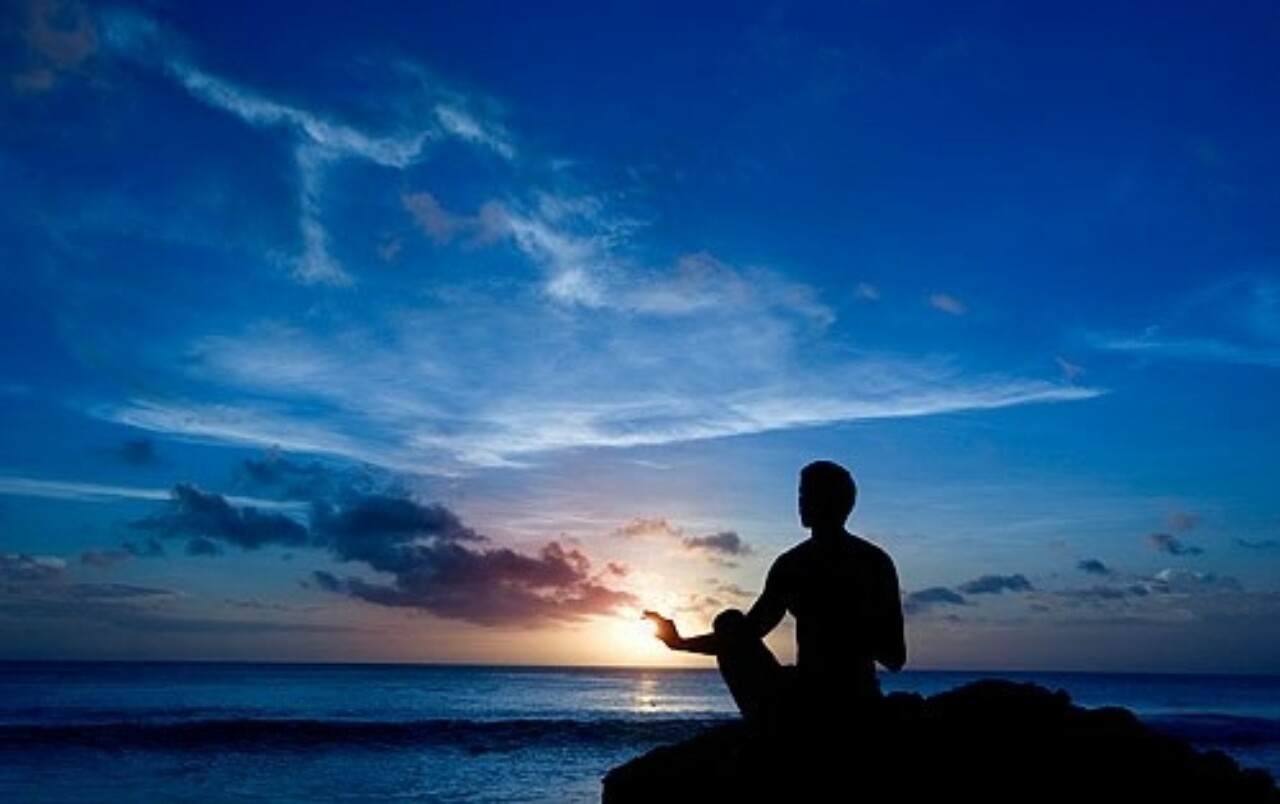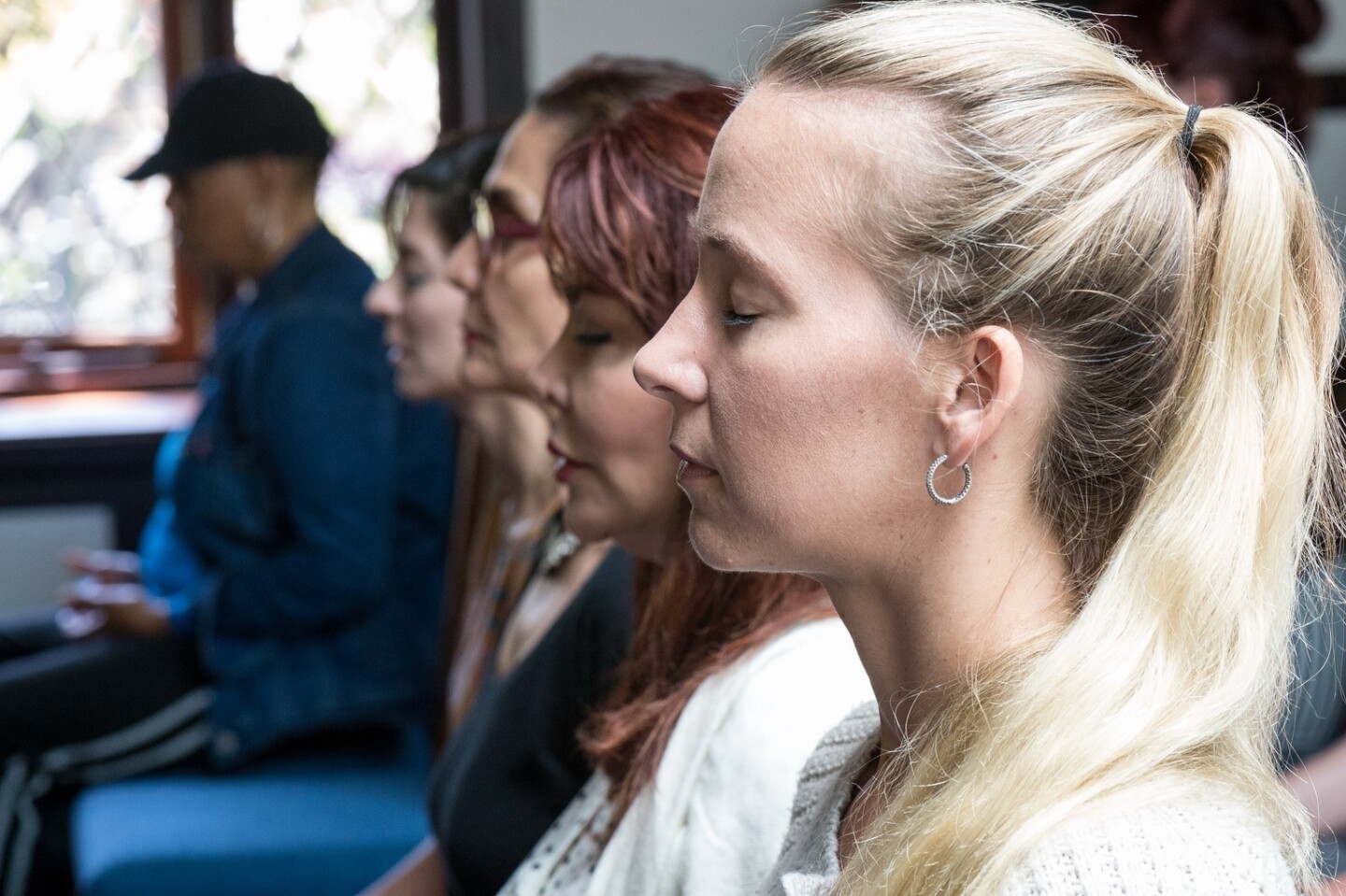Paramahansa Yogananda’s personal instructions on how to practice the science of Kriya Yoga meditation, taken from the classes he gave for more than thirty years, are presented in detail in the Self-Realization Fellowship Lessons.
In addition, the Lessons provide his practical guidance and techniques for attaining balanced physical, mental, and spiritual well-being — the health, healing, success, and harmony that yoga bestows in every aspect of life. These "how-to-live" principles are an absolutely essential component of any truly successful meditation practice.
If you have not yet enrolled for the Lessons, you will find on these pages some basic instructions on how to meditate, which you can use right away to begin experiencing the peace and communion with the Divine that meditation brings.
A Beginner’s Meditation
Further Instruction on the Basics With Brother Achalananda
Ways to Deepen Your Meditation
Meditate with SRF members and friends from around the globe in the comfort of your own home
Learn more techniques for meditation in Paramahansa Yogananda’s Lessons for Home Study
Learn the basic steps of a Beginner’s Meditation as taught by Paramahansa Yogananda.
After you are established in the meditation posture, begin by offering God a prayer from your heart, expressing your devotion and asking His blessings on your meditation.
Tense and Relax to Remove All Stress
- Inhale, tensing the whole body and clenching the fists.
- Relax all the body parts at once and, as you do so, expel the breath through the mouth in a double exhalation, "huh, huhhh."
- Repeat this practice three to six times.
Then forget the breath. Let it flow in and out naturally, of its own accord, as in ordinary breathing.
Focus Attention at the Spiritual Eye
With the eyelids half closed (or completely closed, if this is more comfortable to you), look upward, focusing the gaze and the attention as though looking out through a point between the eyebrows. (A person deep in concentration often "knits" his brows at this spot.) Do not cross the eyes or strain them; the upward gaze comes naturally when one is relaxed and calmly concentrated.
What is important is fixing the whole attention at the point between the eyebrows. This is the Christ Consciousness center, the seat of the single eye spoken of by Jesus: "The light of the body is the eye: if therefore thine eye be single, thy whole body shall be full of light" (Matthew 6:22).
When the purpose of meditation is fulfilled, the devotee finds his consciousness automatically concentrated at the spiritual eye, and he experiences, according to his inner spiritual capacity, a state of joyous divine union with Spirit.
It takes deep concentration and calmness to behold the spiritual eye: a golden halo surrounding a circle of blue, in the center of which palpitates a five-pointed white star. Those who do see the spiritual eye should strive to penetrate it by deeper concentration and by devoted prayer to God. The depth of calmness and concentration necessary for this are naturally developed through steady practice of the scientific Self-Realization Fellowship techniques of concentration and meditation [which are taught in the Self-Realization Fellowship Lessons].
Talk With God in the Language of Your Own Heart
Whether you see the light of the spiritual eye or not, however, you should continue to concentrate at the Christ Consciousness center between the eyebrows, praying deeply to God and His great saints. In the language of your heart invoke Their presence and Their blessings.
A good practice is to take an affirmation or a prayer from the Self-Realization Fellowship Lessons, or from Paramahansa Yogananda's Whispers from Eternity or Metaphysical Meditations, and spiritualize it with your own devotional yearning.
Silently chant and pray to God, keeping the attention at the point between the eyebrows, until you feel God's response as calm, deep peace and inner joy.
Practice Daily to Prepare for the Deeper Techniques
The meditation period should last at least thirty minutes in the morning and thirty minutes at night. The longer you sit, enjoying the state of meditative calm, the faster you will progress spiritually. Carry into your daily activities the calmness you feel in meditation; that calmness will help you to bring harmony and happiness into every department of your life.
Through daily practice of the foregoing instructions, you can prepare yourself for the practice of the deeper techniques of concentration and meditation that are given in the Self-Realization Fellowship Lessons. These scientific techniques will enable you to dive ever more deeply in the great ocean of God's presence. We all exist at this very moment in that ocean of Spirit; but only by steadfast, devoted, scientific meditation may we consciously perceive that we are individualized soul waves on the vast ocean of God's bliss.
From the writings of Paramahansa Yogananda:
"As a first step toward entering the kingdom of God, the devotee should sit still in the correct meditation posture, with erect spine, and tense and relax the body — for by relaxation the consciousness is released from the muscles.
"The yogi begins with proper deep breathing, inhaling and tensing the whole body, exhaling and relaxing, several times. With each exhalation all muscular tension and motion should be cast away, until a state of bodily stillness is attained.
"Then, by concentration techniques, restless motion is removed from the mind. In perfect stillness of body and mind, the yogi enjoys the ineffable peace of the presence of the soul.
"In the body, life is templed; in the mind, light is templed; in the soul, peace is templed. The deeper one goes into the soul the more that peace is felt; that is superconsciousness.
"When by deeper meditation the devotee expands that awareness of peace and feels his consciousness spreading with it over the universe, that all beings and all creation are swallowed up in that peace, then he is entering into Cosmic Consciousness. He feels that peace everywhere — in the flowers, in every human being, in the atmosphere. He beholds the earth and all worlds floating like bubbles in that ocean of peace."
— Paramahansa Yogananda, The Yoga of Jesus

Learn more techniques for meditation in Paramahansa Yogananda’s Lessons for Home Study
One of the first requisites for meditation is correct posture. On this page you will find some simple instructions for your posture that lead to effective meditation.
Erect Spine
During meditation the spine should be held erect. When the seeker is aiming to direct his or her mind and life force upward through the cerebrospinal axis to the centers of higher consciousness in the brain, one should avoid stricture or pinching of the spinal nerves caused by improper posture. To achieve this you can sit in one of the positions described below.
Sitting Cross-Legged or on a Straight Armless Chair
Those persons whose legs are supple may prefer to meditate sitting on the floor, or on a firm bed, in padmasana or a simple cross-legged position.
However, Paramahansa Yogananda also recommended the following comfortable meditation posture:
Sit on a straight armless chair with the feet resting flat on the floor. Hold your spine erect, abdomen drawn in comfortably, chest out, shoulders back, but without undue tension, and chin parallel to the ground. The hands, with palms upturned, should rest on the legs at the juncture of the thighs and the abdominal region to prevent the body from bending forward.
If the correct posture has been assumed, the body will be stable, yet relaxed, so that it is possible to remain completely still, without moving a muscle.
These instructions, except for the positions of the legs and feet, apply also to the cross-legged meditation pose.
Now, close your eyes and gently lift your gaze upward, without straining, to the point between the eyebrows — the seat of concentration, and of the spiritual eye of divine perception.
From the writings of Paramahansa Yogananda:
“If the beginner yogi sits on the hard floor to meditate he will find his legs going to sleep, owing to pressure on his flesh and arteries. If he sits on a blanket over a spring pad or mattress, on the floor, or over a hard bed, he will not experience discomfort in his legs. A Westerner, used to sitting on chairs with his thighs at a right angle to his torso, will find it more comfortable to meditate on a chair with a woolen blanket and silk cloth under him, extending under his feet which rest on the floor. Those Western yogis, especially youths, who can squat on the floor like Orientals, will find their knees pliable, owing to their ability to fold their legs in an acute angle. Such yogis may meditate in the lotus posture, or in the more simple cross-legged position.
“No one should try to meditate in the lotus posture unless he is at ease in that position. To meditate in a strained posture keeps the mind on the discomfort of the body. Meditation should ordinarily be practiced in a sitting position. Obviously, in a standing posture (unless one is advanced) he may fall down when the mind becomes interiorized. Neither should the yogi meditate lying down, for he might resort to the ‘practiced’ state of slumber.
“The proper bodily posture, one which produces calmness in body and mind, is necessary to help the yogi shift his mind from matter to Spirit.”
— Paramahansa Yogananda, God Talks With Arjuna: The Bhagavad Gita
Learn more techniques for meditation in Paramahansa Yogananda’s Lessons for Home Study
It is advisable to find a quiet, peaceful place where you can be secluded and undisturbed during meditation. If possible, set aside some space where you can create your own sanctuary exclusively for your meditation practice (see suggestions below from Paramahansa Yogananda).

From the writings of Paramahansa Yogananda:
"As the parlor awakens social consciousness, the library fosters reading consciousness, and the bedroom suggest sleeping, so everyone should have a room or screened off corner, or a well ventilated closet, used exclusively for the purpose of silent meditation. Traditional homes in India always have such a shrine for daily worship.
"A sanctuary in one's home is very effective in fostering spirituality, because unlike a place of public worship it becomes personalized, and also because it is accessible for spontaneous devotional expressions throughout the day. The children in India are not forced to frequent the shrine, but are inspired to do so by the parents' example.
"In these home temples, families learn to find the soul peace hidden behind the veil of silence. Here they introspect, and in prayer and meditation recharge themselves with the inner power of the soul, and in divine communion attune themselves to discriminative wisdom by which they may govern their lives according to the dictates of conscience and right judgment.
"Interiorized prayer brings forth the realization that peace and service to divine ideals are the goal of life, without which no amount of material acquisition can assure happiness."
— Paramahansa Yogananda, The Second Coming of Christ



